
Vol. II / No. 1
By: H. E. F.
The Maikop Treasure
ALTHOUGH the burial mounds or kurgans of South Russia have for many years been yielding interesting treasures in gold ornaments […]
View Article
Vol. II / No. 1
By: E. H. D.
Four New Geometric Vases
ONE of the most striking phenomena of Greek decorative art is the appearance in about 1000 B.C. of a style […]
View Article
Vol. II / No. 1
By: A. K. Coomaraswamy
A Trinity of Fortune
NEW iconographic type of considerablc interest is presented by two almost identical reliefs, one (Plate VII) now in the University […]
View Article
Vol. II / No. 3
By: J. A. M.
The Air Survey in Central America
THE aerial archeological expedition to the Maya region, an announcement of which was published in the last number of the […]
View Article
Vol. II / No. 3
By: H. U. H.
A Wood-Carving from New Guinea
THE great island of New Guinea, to the north of Australia, is next in size to Greenland among the islands […]
View Article
Vol. II / No. 3
By: E. H. D.
An Amphora from the Hope Collection
TO the third quarter of the fifth century before Christ has been assigned a large group of vases associated with […]
View Article
Vol. II / No. 3
By: J. A. M.
A Naskapi Indian Robe
AMONG the most interesting objects in a collection recently acquired from the Naskapi Indians of northern Labrador are the robes, […]
View Article
Vol. II / No. 4
By: E. H. D.
Two Plastic Vases
STUDENTS of aesthetics have noted the difference in the kind of pleasure derived from looking at a small object of […]
View Article
Vol. II / No. 4
By: H. U. H.
A Bushman Collection
THE Museum has received, through the kindness of Mr. and Mrs. Rodolphe M. de Schauensee, a valuable collection of objects […]
View Article
Vol. II / No. 5
By: E. H. D.
Two Greek Sculptures
TWO Greek heads have recently been put on exhibition in the Pepper Gallery at the head of the main stairs. […]
View Article
Vol. II / No. 5
By: H. E. F.
A Chinese Bronze
THE latest acquisition in the Department of Chinese Art is a very early bronze vessel, about seven inches high. It […]
View Article
Vol. II / No. 5
By: H. U. H.
A Batetela Image
THE wooden figurine of Plate VII, representing a seated female, was once the property of a medicine-man of the Sankuru […]
View Article
Vol. II / No. 5
By: H. N. W.
Totonacan Stone Mask and Head
THE Mexican exhibits have been enriched by the addition of a superb jadite mask and a head carved from fine-grained […]
View Article
Vol. II / No. 6
By: L. L.
A Collection of Bronzes from Luristan
THE Museum has just acquired a remarkable collection of Persian bronzes, some of which were on view in the recent […]
View Article
Vol. II / No. 6
By: Ananda K. Coomaraswamy
A Relief and Inscription from Kashmir
THE relief illustrated in Plate XII was found on the site of Huskapura (modern Ushkur), near Baramula in Kashmir, by […]
View Article
Vol. III / No. 1
By: J. A. M.
A Maya Carved Stone Lintel from Guatemala
THE most important and spectacular discovery made by the Eldridge R . Johnson Expedition to the ancient Maya city of […]
View Article
Vol. III / No. 1
By: J. A. M.
A Peruvian Painting Set
ONE of the most interesting of the recent accessions to the American Section is a group of small objects [Plate […]
View Article
Vol. III / No. 1
By: E. H. D.
A Greek cup by the ‘Foundry Painter’
THE Museum has had the good fortune to acquire, through the generous gift of Mr. Arthur H. Lea, a Greek […]
View Article
Vol. III / No. 1
By: H. E. F.
Additions to the Chinese Collection
RECENT acquisitions in the Chinese section include a group of seven teen pieces of mortuary pottery. The pottery is of […]
View Article
Vol. III / No. 3-4
By: H. N. W.
The Brock Collection of Baskets
THE art of the basket-maker reached its highest development among the tribes of the California region, a number of which […]
View Article
Vol. III / No. 5
By: H. N. W.
The Charles H. Stephens Collection
THE Hall of South American Archaeology has been transformed by the temporary exhibition of a goodly portion of the Charles […]
View Article
Vol. III / No. 6
By: H. U. H.
The African Collections
THROUGH the recent assignment of a greater amount of room to the African collections than was formerly available, it is […]
View Article
Vol. III / No. 6
By: B. G.
A Sculpture From Meydûm
WE publish this month [Plate XIV] a photograph, recently received from Mr. Rowe, of the limestone relief, believed to represent […]
View Article
Vol. IV / No. 1
By: J. J.
Two Sculptures from Minturnæ
TWO terra-cotta sculptures found in the course of last season’s work at Minturnae are here shown, in Plates IV and […]
View Article
Vol. IV / No. 1
By: E. H. D.
The Cyprus Expedition
A NEW epoch has begun in the excavation of antiquities in Cyprus. In the past the looting of tombs and […]
View Article
Vol. IV / No. 1
By: L. L.
The Sabean Collection
THE recent reinstallation on the upper floor of the Museum has permitted the display of a collection, purchased several years […]
View Article
Vol. IV / No. 1
By: J. A. M.
Peruvian Pottery Whistles
AMONG the most interesting objects secured by the late Dr. William C. Farabee on his last trip to Peru (see […]
View Article
Vol. IV / No. 1
By: F. de L.
An Alaskan Stone Lamp
THE Museum has been fortunate in acquiring a second example of the same type as the remarkable stone lamp, decorated […]
View Article
Vol. IV / No. 2
By: E. G.
The Development of the Russian Project
IN the Bulletin for January 1932, we reported on the survey which Mr. Eugene Golomshtok had made for the Museum, […]
View Article
Vol. IV / No. 2
By: E. G.
Traces of a Blond Race in Siberia
THE general region of Central Asia has been pointed out as the probable cradle of the Caucasian race. The traces […]
View Article
Vol. IV / No. 2
By: E. H. D.
A Corinthian Amphora
THE Museum has recently received on loan a collection of vases made by the late Hermann Hilprecht, one of the […]
View Article
Vol. IV / No. 2
By: J. J.
A Marble Head from Minturnae
ONE of the earliest areas to attract the attention of the staff of the Museum’s Expedition to Minturnæ was a […]
View Article
Vol. IV / No. 2
By: J. A. M.
Jade Ornaments from Piedras Negras
JADE was the material most highly prized by the ancient peoples of Mexico and Central America who regarded it as […]
View Article
Vol. IV / No. 2
By: F. de L.
Three Carvings from Cook Inlet, Alaska
THREE interesting representations of human heads were secured in 1932 from a site in Kachemak Bay, Cook Inlet, Alaska, of […]
View Article
Vol. IV / No. 3
By: E.H.D.
Exekias
AMONG the most beautiful fragments of painted vases, from Orvieto, Italy, which were acquired in 1897 with the consent of […]
View Article
Vol. IV / No. 3
By: E. H.
An African Wood-carving
AN addition to the African Collection has been made through the gift by Mrs. William Godfrey of the fetish figure […]
View Article
Vol. IV / No. 3
By: B. G.
Objects from Meydûm
THE objects received from the Meydûm excavations of the season 1931-1932 are, although chiefly of the later periods, very varied […]
View Article
Vol. IV / No. 3
By: A. J. T.
Two Incense-burners from Beth-shan
THE discovery at Tell Billa and Tepe Gawra of several interesting incense-burners, the most notable being the painted example now […]
View Article
Vol. IV / No. 3
By: E. B. H.
Folsom Points and Glacial Man
A FEW years ago the town of Folsom, New Mexico, was put on the map. This event does not seem […]
View Article
Vol. IV / No. 4
By: J. A. M.
Stela 12 from Piedras Negras
THE stelae from the Early ‘Empire’ Maya city of Piedras Negras in Guatemala, secured by the Eldridge R. Johnson Expedition, […]
View Article
Vol. IV / No. 4
By: J. A. M.
A Remarkable Throne from Guatemala
PROBABLY the most interesting single discovery of the work in 1932 of the Eldridge R. Johnson Expedition at Piedras Negras […]
View Article
Vol. IV / No. 4
By: J. A. M.
Gold and Copper Ornaments from Peru
MR . CHARLES L. CHANDLER has recently presented the Museum with three dainty metal objects from prehistoric Peru. These were […]
View Article
Vol. IV / No. 4
By: H. E. F.
Two Pottery Tiles from a Han Dynasty Tomb
TWO important additions have recently been made, by purchase, to the Chinese collections in the Museum, in the form of […]
View Article
Vol. IV / No. 4
By: M. R. W.
The Cleaning and Restoration of Ancient Bronzes
ALMOST without exception the bronze and copper objects received in the Museum are in the process of disintegration. This disintegration […]
View Article
Vol. IV / No. 5
By: L. S.
The Piedras Negras Expedition
THERE is a tradition among archaeologists that something important is sure to turn up about the last week of the […]
View Article
Vol. IV / No. 5
By: E. B. H.
Excavations in New Mexico
THE field-work for the University Museum in the Southwest has just been concluded for this year, and, though certain phases […]
View Article
Vol. IV / No. 5
By: H. N. W.
The Franklin Peale Collection
THREE quarters of a century ago, a member of the notable Peale family, identified with the artistic life of Philadelphia, […]
View Article
Vol. IV / No. 5
By: F. de Laguna
The Alaskan Expedition
AN unexpected discovery of great interest was made in Alaska this summer by Miss Frederica de Laguna, of the Museum […]
View Article
Vol. V / No. 1
By: H. U. H.
A New Guinea Oracle
IN the coastal region of Geelvink Bay, in the north of Dutch New Guinea, the people practise a cult of […]
View Article
Vol. V / No. 1
By: B. G.
An Early Egyptian Door-Socket
ONE of the most interesting objects in the Egyptian Section is the very early stone door-socket [Plates VI and VII] […]
View Article
Vol. V / No. 1
By: J. J.
An Egyptian Landscape at Minturnae
IN Plate VIII is shown a restored terra-cotta plaque of a type represented by numerous fragments in the excavations at […]
View Article
Vol. V / No. 1
By: H. N. W.
Guatemalan Textiles
MRS. E. A. OSBORNE, with the tireless zeal of the amateur, has gathered from the quaint mountain villages of Guatemala […]
View Article
Vol. V / No. 1
By: J. A. M.
A Stucco Head from Guatemala
THE pyramids, temples, and other structures of the so-called Old Maya Empire were completely covered with plaster and stucco. The […]
View Article
Vol. V / No. 1
By: E. H.
For Junior Members: Chinese Dragons
THE Dragons of the Western World are dead, and a good thing too, no doubt, for on the whole they […]
View Article
Vol. V / No. 2
By: E. H. D.
A Pair of Earrings from Cyprus
WHENEVER Homer mentions a work of exquisite handicraft he attributes it to the Phœnicians. It is Phœnician women who stain […]
View Article
Vol. V / No. 2
By: E. G.
Bronze Bird Figures from Russia
AMONG the numerous examples of the bronze work from Russia and Siberia recently acquired by the Museum through exchanges with […]
View Article
Vol. V / No. 2
By: H. E. F.
An Early Chinese Sculpture
DECORATED stone pedestals for the support of Buddhist statues are among the best of the early sculptures of China. The […]
View Article
Vol. V / No. 5
By: Dr. J. Alden Mason
Three Inca Wooden Cups
IN THE course of the “housecleaning” of the Peruvian material in storage, which has lain untouched for many years, two […]
View Article
Vol. V / No. 2
By: J. A. M.
A Stela from Piedras Negras
THERE are now shown in the Middle American Hall four monumental stelae from Pied.ras Negras, one of the results of […]
View Article
Vol. V / No. 2
By: F. de L.
Ceremonial Paddles from the Eyak Indians, Alaska
THE Joint Expedition to Alaska of the University Museum and the Danish National Museum was fortunate in securing two specimens […]
View Article
Vol. V / No. 2
By: E. H.
For Junior Members: Indian Dolls
IN the American Indian Section of the Museum, among the weapons once used in fighting and hunting, among the clothing […]
View Article
Vol. V / No. 3
By: Vincent Petrullo
Research in Venezuela
MR. VINCENZO PETRULLO, the Museum’s field director for South American Research , was sent to Venezuela in July, 1933 to […]
View Article
Vol. V / No. 3
By: V. P.
Mr. Petrullo’s Report
THE region lying between the Apure and the Meta rivers (both of which are western tributaries of the Orinoco) is […]
View Article
Vol. V / No. 3
By: J. A. M.
A Pottery Vessel from Mexico
THE most notable recent addition to the Mexican collections is a remarkable pottery vessel [Plate VI] lent to the Museum […]
View Article
Vol. V / No. 3
By: B. G.
A Head from an Egyptian Royal Statue
THE fine head of an Egyptian ruler shown on Plates X and XI was purchased by the Museum from an […]
View Article
Vol. V / No. 3
By: E. H. D.
An Italic Head
THE Museum has recently acquired a terracotta head slightly under life-size, of unknown provenance [Plate XII]. The massive neck and […]
View Article
Vol. V / No. 4
By: Henry Usher Hall
Malagan of New Ireland
THE gallery lately devoted to a part of the African collections now contains, newly installed, a selection from those of […]
View Article
Vol. V / No. 4
By: G. H. McF.
The Cyprus Expedition
The Museum’s Excavations in Cyprus were resumed in the spring of 1934. The site chosen by Mr. B. H. Hill, […]
View Article
Vol. V / No. 4
By: B. G.
The New Mummy Room
It is with regret for the Museum that we announce the appointment of Battiscombe Gunn, lately Curator of the Egyptian […]
View Article
Vol. V / No. 4
By: M. L. M.
How Mummies Were Made
PEOPLE far and wide show an almost morbid interest in mummies. The word “mummy” immediately suggests Egypt and with justification, […]
View Article
Vol. V / No. 4
By: J. A. M.
Gold in Ancient America
So much is the question of gold in the minds of all of us, that it is not out of […]
View Article
Vol. V / No. 5
By: Dorothy Cross
Objects From Ur
THE Museum’s share of objects found during the final season of excavations at Ur are now being sorted and catalogued. […]
View Article
Vol. V / No. 5
By: Dr. Erich F. Schmidt
The Persian Expedition
THE achievements of the first season of the Joint Expedition to Rayy of the Boston Museum of Fine Arts and […]
View Article
Vol. V / No. 5
By: Dr. Frederica de Laguna
Eskimo Dug-Outs
THE expedition of the University Museum and the Danish National Museum to Prince William Sound, Alaska, In 1933, acquired three […]
View Article
Vol. V / No. 5
By: H. U. Hall
Maori War Canoe Ornaments
THE Oceanian exhibition lately installed in the east wing of the Museum includes several fine examples of the prow and […]
View Article
Vol. V / No. 5
By: E. H. D. and H. E. F.
Book Reviews
FROM time to time books come to the attention of our Curators which are both readable and authoritative and which […]
View Article
Vol. V / No. 6
By: J. J.
The Great Mound
IN the sixth millennium before Christ a migrating horde swept from the east over India, Persia and Mesopotamia. Many more […]
View Article
Vol. V / No. 6
By: E. H. D.
Attic Vases from Memorial Hall
THE loan that is described in the following article represents more than a merely satisfactory acquisition to the University Museum’s […]
View Article
Vol. V / No. 6
By: E. H. D.
A Statue of Athena
THROUGH the generosity of Mr. Raymond Pitcairn, the Museum has received as a loan a very interesting statue, somewhat under […]
View Article
Vol. V / No. 6
By: M. B.
A Maya Pottery Vase
THE Maya Indians developed pottery-making into a considerable art. No other people of pre-Columbian America attained the same skill in […]
View Article
Vol. VI / No. 1
By: L. S., Jr.
The Black Rocks
THE following article by Mr. Satterthwaite, Field Director of the Museum’s Expedition to Piedras Negras, Guatemala, covers the work accomplished […]
View Article
Vol. VI / No. 1
By: E. H. D.
A Daphnae Situla from Memphis
THE Egyptian collections of the Museum include a number of fragmentary Greek Vases found in Egypt. One of these, a […]
View Article
Vol. VI / No. 1
By: H. H. F. J.
The Museum’s Loan to Burlington House
THE Museum was gratified to be invited and pleased to be in a position to lend an important group of […]
View Article
Vol. VI / No. 1
By: E. A. G.
Easter Island Wood Carvings
IN proportion to its size of scarcely thirty-six square miles, Easter Island or Rapanui has provoked more discussions and has […]
View Article
Vol. VI / No. 1
By: C. B.
Obsidian Vessels from Tepe Gawra
INTRUSIVE in Level 11 of the Great Mound were discovered last year a number of Libn tombs described from time […]
View Article
Vol. VI / No. 2
By: M. L. M.
The Stela of Mery
BETWEEN the first and second cataracts of the Nile, in lower Nubia lies the modern village of Anibeh. There during […]
View Article
Vol. VI / No. 2
By: J. A. M.
Collections from Santarem
DESPITE its immense extent, the Amazonian region is without doubt the the area least known in America from an archaeological […]
View Article
Vol. VI / No. 2
By: F. de L.
Expedition to the Yukon
The following article by Dr. Frederica de Laguna gives an account of the work of the Museum’s recent expeditions to […]
View Article
Vol. VI / No. 2
By: J. J.
The Road from Rome
An Expedition from the Museum excavated at the site of Minturnae, Italy, from 1931 to 1933, uncovering its Republican forum, […]
View Article
Vol. VI / No. 2
By: J. A. M.
Mexican and Mayan Sweat-Baths
In the last issue of the Bulletin Mr. Satterthwaite referred to the problem of sweat-baths in the Maya area and […]
View Article
Vol. VI / No. 3
By: E. S.
Rayy Research 1935: Part I
The Second Season Begins THE first excavation season at any site is usually a period of sounding and learning. The […]
View Article
Vol. VI / No. 3
By: V. P.
Guajiro Expedition 1935
THE Expedition to the Guajiro Peninsula which was dispatched on April 23rd under the sponsorship of the Museum and Columbia […]
View Article
Vol. VI / No. 3
By: H. H. F. J.
Palace Ladies
AMONG the Museum’s Chinese paintings sent to the Exhibition of Chinese Art in Burlington House the outstanding one was probably […]
View Article
Vol. VI / No. 3
By: C. B.
Gawra XII
THE Museum’s Expedition to Tepe Gawra left Philadelphia early in September. During the last field season the discovery of Level […]
View Article
Vol. VI / No. 3
By: H. N. W.
Taino Figurines
WHEN Columbus landed on the shore of the New World the natives greeted his messengers with the cry “Taino! Taino!” […]
View Article
Vol. VI / No. 4
By: C. B.
The Round House at Gawra
ACTIVE work of the Expedition to Tepe Gawra, supported jointly by the American Schools of Oriental Research and the Museum, […]
View Article
Vol. VI / No. 4
By: M. M. C.
An Egyptian Mummy Cloth
DURING the Roman Period in Egypt (30 B. C.-395 A. D.) one Ḥor, son Ḥarisēset born of Tedikhety(?), died and […]
View Article
Vol. VI / No. 4
By: M. L. B.
Lintel 3 Restored: And Why
LINTEL 3, very generally granted to be among the finest achievements of the Maya Sculptors, was discovered in a much […]
View Article
Vol. VI / No. 4
By: H. N. W.
A Mexican Effigy Pipe
THE ceremonial use of tobacco held an important place in the religious rites of the Mexican peoples, yet pipes are […]
View Article
Vol. VI / No. 4
By: E. H. D.
A Bell-Krater by the Christie Painter
SOME years ago Professor Alfred Mansfield Brooks of Swarthmore College had the good fortune to discover in the public market […]
View Article
Vol. VI / No. 4
By: E. A. G.
Ural Bronzes
IN 1933 the Museum acquired by exchange with several Museums of the U.S.S.R. a considerable collection of small bronzes from […]
View Article
Vol. VI / No. 4
By: E. S.
Rayy Research, 1935: Part II
THE continuation of Dr. Schmidt’s report on the 1935 season of the Joint Expedition to Iran covers two important phases […]
View Article
Vol. VI / No. 4
By: J. A. M.
Archaeological Work in Durango During March, 1936
DR. MASON has been engaged in research in northern Mexico since early December on an extension of Dr. Edgar B. […]
View Article
Vol. VI / No. 5
By: P. M.
Stela of Sisopduyenhab and His Relatives
THERE is now on exhibition in the Upper Hall of the Coxe Egyptian wing an interesting stela of limestone which […]
View Article
Vol. VI / No. 5
By: M. B.
Archaeology in Western Pennsylvania
ALTHOUGH few of us think that archaeology, like charity, can begin at home, digging in Pennsylvania has gone on spasmodically […]
View Article
Vol. VI / No. 5
By: L. S., Jr.
The Sixth Piedras Negras Expedition
MAYAN carved and dated monuments, so splendidly represented in our museum by originals from Piedras Negras, are found scattered over […]
View Article
Vol. VI / No. 5
By: E. H. D.
Two Syrian Sculptured Portraits
THROUGH the generosity of Max, Freiherr von Oppenheim, the Museum has on display in the Roman Gallery of the Sharpe […]
View Article
Vol. VI / No. 5
By: E. B. H.
The First Americans
JOINT work of the University Museum and the Academy of Natural Sciences and the Carnegie Institution was continued in New […]
View Article
Vol. VI / No. 5
By: H. H. F. J.
Po Shan Lu
“IT is an old affair of the Han Dynasty. When the rulers are married they bestow po shan lu or […]
View Article
Vol. VI / No. 6
By: L. L.
The Museum’s Gudea
The death of Gustav Oberlaender on November 30th has brought a unique sense of loss to the officers and members […]
View Article
Vol. VI / No. 6
By: H. N. W.
Eskimo Tun-Ghat Mask
THE rare mask which was collected from the Eskimo of Hooper Bay, Western Alaska, by W. B. Van Valin, is […]
View Article
Vol. VI / No. 6
By: H. U. Hall
The African Expedition
Mr. Henry U. Hall, who is conducting investigations for the Museum among primitive tribes in Sierra Leone, Africa, writes the […]
View Article
Vol. VI / No. 6
By: E. A. S.
Khafaje, 1937
IMMEDIATELY after receiving word that funds were available, Dr. Speiser undertook to carry on a brief season of excavations on […]
View Article
Vol. VI / No. 6
By: E. A. S.
The Oldest Acropolis
TEPE Gawra has been recognized, since its discovery ten years ago, as a site of fundamental importance for the cultural […]
View Article
Vol. VI / No. 6
By: Hermann Von Walde-Waldegg
An Expedition to San Agustin and the Indian Reservation of Tierradentro in Southern Colombia
FROM June until November 1936, I had the privilege of leading an expedition in Southern Colombia under the auspices of […]
View Article
Vol. VII / No. 1
By: H. U. H.
The West African Expedition: November, 1936 - June, 1937
THE Expedition was undertaken by the Museum with the aid of a grant from the American Philosophical Society, for the […]
View Article
Vol. VII / No. 1
By: H. N. W.
Chief Gabriel Paul’s Treasure
BY the generous gift of Dr. Samuel W. Fernberger, the University Museum has received a collection of interesting objects, formerly […]
View Article
Vol. VII / No. 1
By: L. S., Jr.
Thrones at Piedras Negras
THE seventh Piedras Negras Expedition worked at the ruins of this ancient Maya city from March 22nd to July 4th, […]
View Article
Vol. VII / No. 1
By: P. M.
A Granite Relief of Ptolemy II
THE portion of granite bas-relief on exhibition on the east wall of the Lower Hall of the Egyptian wing shows […]
View Article
Vol. VII / No. 1
By: E. S.
Tol-E-Bakun: Prehistoric Mound Near Persepolis
THE Iranian Expedition, sponsored jointly by the Oriental Institute of Chicago, the Boston Museum of Fine Arts and the University […]
View Article
Vol. VII / No. 1
By: C. H. D.
Educational Department
FOR the past two years enforced economies within the Museum necessitated the initiation of a charge for docent service to […]
View Article
Vol. VII / No. 2
By: G. H. McF. and J. F. D.
Excavations at Kourion
THE purpose of the excavations al Kourion is to trace the history of that ancient city in the different sites […]
View Article
Vol. VII / No. 2
By: H. H. F. J.
American Indian Portraits
THE current exhibition of Portraits of American Indians from Poca hontas to Sitting Bull is, in a manner, a departure […]
View Article
Vol. VII / No. 2
By: J. A. M.
Impressions of an Ethnologist
So great was the appeal of European articles of apparel and adornment to the American Indian that they were adopted […]
View Article
Vol. VII / No. 2
By: H. N. W.
Defensive and Offensive Power of the Shield
TWO superb Dakota shields recently added to the collections of the University Museum reveal the true meaning of the Indian […]
View Article
Vol. VII / No. 3
By: H. H. F. J.
Amitabha Altar Group
THE Museum’s great collection of Chinese antiquities, especially in the field of Buddhist sculpture has been increased and strengthened in […]
View Article
Vol. VII / No. 3
By: H. N. W.
American Indian Baskets
THE University Museum’s outstanding collection of baskets has been enriched by some sixty American Indian baskets, notable for their beauty […]
View Article
Vol. VII / No. 3
By: J. F. D.
Kourion: The Late Bronze Age Settlement
SINCE 1935 the Museum has been conducting under its auspices, partly through the generosity of Mr. George H. McFadden and […]
View Article
Vol. VII / No. 3
By: H. N. W.
Guetar Art in Stone
WHEN the Great Admiral first touched the mainland on his final voyage to the western hemisphere, he found a numerous […]
View Article
Vol. VII / No. 3
By: P. M.
Conversations and Calls Recorded on the Walls of the Tomb of Kaipurē
THE offering chamber of this tomb, which is located at the southern end of the lower Egyptian hall, was described […]
View Article
Vol. VII / No. 4
By: L. S. Jr.
Evolution of a Maya Temple: Part 1
MOST of the 1939 effort at Piedras Negras went into discovering the forms of three temples, one over the other […]
View Article
Vol. VII / No. 4
By: E. H. D.
A Mosaic From Cento Celle
INTEREST in ancient mosaics has been stimulated of late both by Pernice’s publication of mosaics from Pompeii, and by the […]
View Article
Vol. VII / No. 4
By: H. N. W.
An Ancient Paracas Manta
NO greater masters of the textile arts probably ever plied their craft in the Western Hemisphere than the early dwellers […]
View Article
Vol. VII / No. 4
By: H. H. F. J.
The University Museum: 1938-1939
THE past year witnessed the Museum’s steady progress with only a few alterations in its usual course of activities. Expeditions […]
View Article
Vol. VII / No. 4
By: J. A. M. and H. H. F. J.
Book Reviews
PLAINS INDIAN PAINTING, A Description of an Aboriginal Art, by John Canfield Ewers Pp. xiv-84. Pls. 45. Stanford University Press, […]
View Article
Vol. VIII / No. 1
By: J. F. D.
The Achaeans at Kourion
THE University Museum has played a distinguished part in the rediscovery of the pre-Hellenic civilization of Greece. The Heroic Age […]
View Article
Vol. VIII / No. 1
By: L. L.
Nippur Old Drugstore
HERB doctors, Medicine men, and Drugstore prescriptions, may now trace their origin to a respectable antiquity: a welcome piece of […]
View Article
Vol. VIII / No. 1
By: H. N. W.
Fictile Art of the Mochicas
THE isolated coastal valleys of northern Peru, some fifteen hundred years ago, were the home of a people whose realistic […]
View Article
Vol. VIII / No. 1
By: H. R.
A Contemporary of Queen Hatshepsut
THE Eckley B. Coxe Expedition of 1909 to Buhen in Nubia found a beautiful dark diorite1 statuette of a man […]
View Article
Vol. VIII / No. 1
By: J. A. M.
Book Reviews
INDIAN ARTS IN NORTH AMERICA, by George C. Vaillant. Pp. xiii-63. Pls. 96 and colored frontispiece. Harper & Brothers, New […]
View Article
Vol. VIII / No. 2-3
By: H. H. F. J.
Exhibition of Archaic Chinese Bronzes
THE Museum is privileged to be able to display, coincidentally with the current Exhibition of Archaic Chinese Jades, a group […]
View Article
Vol. VIII / No. 2-3
By: E. H. D.
Locrian Terracotta Plaques
ON a promontory that runs down to the Ionian Sea almost at the southermost point of Italy, Locrians from Greece […]
View Article
Vol. VIII / No. 2-3
By: L. S. Jr.
Evolution of a Maya Temple: Part II
IN the November issue of the Bulletin (Vol. 7, No. 4) we illustrated the changing forms of a Piedras Negras […]
View Article
Vol. VIII / No. 2-3
By: L. S. Jr.
Another Piedras Negras Stela
MAYA carved monuments fall into various categories, the most numerous being “stelae”. These are long shafts set upright in the […]
View Article
Vol. VIII / No. 2-3
By: H. R.
An Unfinished Statue of the Twelfth Dynasty
Title Reference1 THE limestone statue which is published here for the first time comes from Flinders Petrie’s excavations at “Kahun” […]
View Article
Vol. VIII / No. 4
By: J. S. J.
The University Museum
IN CELEBRATING the Bicentennial of the University we are also marking with pride the fifty-second year of the existence of […]
View Article
Vol. VIII / No. 4
By: H. H. F. J.
The Doors of the Waiting Dogs
AN acquisition of especial interest has recently been made to the collections of Chinese sculpture. The Museum is widely recognized […]
View Article
Vol. VIII / No. 4
By: H. R.
A Statue of the Goddess Hathor
THE Museum has recently acquired the torso1 of an Egyptian life-size female statue of greyish-black granite2. The woman is shown […]
View Article
Vol. VIII / No. 4
By: J. A. M.
Ivory and Resin Figurines from Coclé
THOUGH not so spectacular as the great heavy gold plaques, by all odds the most interesting, most exquisite and most […]
View Article
Vol. VIII / No. 4
By: G. H. McF.
Sanctuary of Apollo at Kourion
EXCAVATIONS were resumed in the Sanctuary of Apollo1 (Plan 1) on the 28th of April 1939 and continued until the […]
View Article
Vol. IX / No. 1
By: H. H. F. J.
Maitreya and Guardians
THE dating of early Chinese Buddhist sculpture is based, of necessity, on two classes of objects, first those that bear […]
View Article
Vol. IX / No. 1
By: L. L.
Nippur Again
I.-Sumerian Heads AMONG the treasures of the Babylonian Section are now exhibited two small but valuable Sumerian heads, cut in […]
View Article
Vol. IX / No. 1
By: H. N. W.
Hopi Kachinas
IN the kivas of the Hopi pueblos, the men are busy, for the sun has almost reached the farthest point […]
View Article
Vol. IX / No. 1
By: H. R.
An Egyptian Tombstone of the New Kingdom
THE tombstone shown in Plates VIII, 1 which recently was acquired for the University Museum, is unusually informative. While most […]
View Article
Vol. IX / No. 1
By: V. C. B.
Ancient Needles
THE origin of the sewing needle goes back, beyond written history, to the Palaeolithic age. This was the time when […]
View Article
Vol. IX / No. 2-3
By: Horace H. F. Jayne
Introduction: The Chinese Collections of the University Museum
THE Museum, almost since its first establishment, included a few objects from China. For several decades, however, expansion in this […]
View Article
Vol. IX / No. 2-3
By: Horace H. F. Jayne
A Handbook of the Principal Objects: The Chinese Collections of the University Museum
THE collections on display are distributed in three galleries: Upper Pepper Hall at the top of the main staircase; Harrison […]
View Article
Vol. IX / No. 2-3
By: Horace H. F. Jayne
Appendix I: The Chinese Collections of the University Museum
PAIR OF CHIMAERAS University Museum Journal, Vol. XVIII, No. 2, June 1927, pp. 159-173, Two Colossal Stone Chimeras from A […]
View Article
Vol. IX / No. 2-3
By: Horace H. F. Jayne
Appendix II: The Chinese Collections of the University Museum
Brief descriptions of less important objects not mentioned in the foregoing survey, but which are usually on exhibition in Harrison […]
View Article
Vol. IX / No. 4
By: Percy C. Madeira, Jr.
President’s Message
ON this occasion when The University Museum reviews its work for the year, I want to express my appreciation of […]
View Article
Vol. IX / No. 4
By: George C. Vaillant
Report of the Director
THE University Museum has had a year of considerable accomplishment in spite of events within and without the Museum which […]
View Article
Vol. IX / No. 4
By: Linton Satterthwaite, Jr.
Two Maya Bowls: A Problem in Reconstruction
ACTION such as we see in Plates II-III is rare in Maya art, probably because so little of Maya painting […]
View Article
Vol. IX / No. 4
By: Hermann Ranke
A Late Saitic Statue from the Temple of Neith at Sais
IN December 1941 the University Museum acquired1 a headless kneeling statue of black basalt2 of the period of the so-called […]
View Article
Vol. IX / No. 4
By: Helen E. Fernald
In Defense of the Horses of T’ang T’ai Tsung
THERE is, it seems, still some question in the minds of certain students of Chinese art whether the famous stone […]
View Article
Vol. IX / No. 4
By: Cornelia Dam
Museum Education in Wartime
IN spite of a fifty per cent reduction in the available docent service hitherto provided by the Museum, the Educational […]
View Article
Vol. X / No. 1-2
By: J. Alden Mason
Preface: American Collections The Ancient Civilizations of Middle America
THE Middle American Halls of The University Museum contain one of the world’s best collections of objects produced by the […]
View Article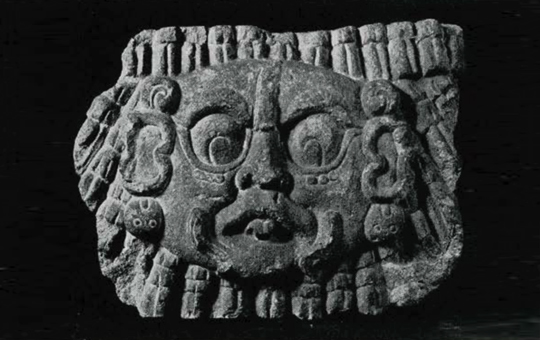
Vol. X / No. 1-2
By: J. Alden Mason
Introduction: American Collections The Ancient Civilizations of Middle America
THE massive pyramids of southern Mexico, Yucatan and Guatemala, dominating their surroundings, epitomize the nature of the theocratic civilizations that […]
View Article
Vol. X / No. 1-2
By: J. Alden Mason
The Valley of Mexico: American Collections The Ancient Civilizations of Middle America
Of the early nomadic hunting peoples of Mexico who must have preceded the sedentary agricultural ones we know nothing. So […]
View Article
Vol. X / No. 1-2
By: J. Alden Mason
The Maya: American Collections The Ancient Civilizations of Middle America
THE forested lowlands of the present Guatemala, Yucatan, and adjacent parts of southern Mexico and northern Honduras produced the highest […]
View Article
Vol. X / No. 1-2
By: J. Alden Mason
Other Theocratic Cultures of Mexico: American Collections The Ancient Civilizations of Middle America
WE have described the Aztecs and their culture in some detail because they were in their zenith at the time […]
View Article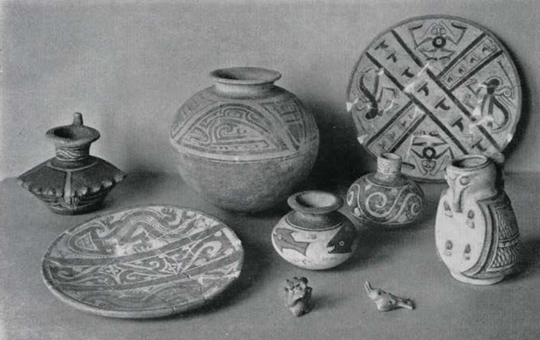
Vol. X / No. 1-2
By: J. Alden Mason
The Lesser Archaeological Cultures of Mexico and Central America: American Collections The Ancient Civilizations of Middle America
TO the northwest of Mexico City, in the state of Michoacan and around Lake Patzcuaro, lived and live the Tarascan […]
View Article
Vol. X / No. 1-2
By: J. Alden Mason
The Indian Peoples of Middle America Today: American Collections The Ancient Civilizations of Middle America
IN contrast to the United States, where Indians form an infinitesimal part of the population in the urban, industrial and […]
View Article
Vol. X / No. 1-2
By: J. Alden Mason
Notes For Further Reading: American Collections The Ancient Civilizations of Middle America
THE literature on Middle American archaeology is voluminous, with a few sound and reliable, popular readable books by recognized authorities, […]
View Article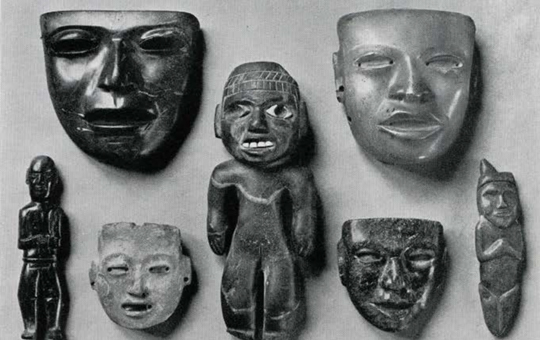
Vol. X / No. 1-2
By: J. Alden Mason
Publications of the University Museum on Middle America: American Collections The Ancient Civilizations of Middle America
Information on and prices of the following publications will gladly be sent on request to the Secretary. Those preceded by […]
View Article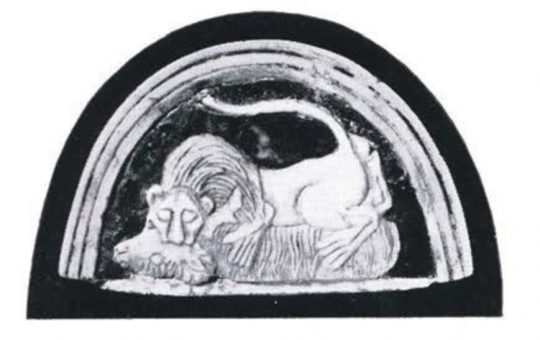
Vol. X / No. 3-4
By: Leon Legrain
Chronology*: The Babylonian Collections of the University Museum
THE succession of archaeological periods in Mesopotamia in the IVth and IIIrd millennia is fairly well established. However, absolute dates […]
View Article
Vol. X / No. 3-4
By: Leon Legrain
Introduction: The Babylonian Collections of the University Museum
HERE is a little historical guide, composed for the visitor to the Babylonian Section of the University Museum, so that […]
View Article
Vol. X / No. 3-4
By: Leon Legrain
The Assyrian Relief of Ashurnasirpal: The Babylonian Collections of the University Museum
This is the Assyrian monument (Figure 1) sent in 1853 from Mosul dy the Rev. W. Frederic Williams, American missionary, […]
View Article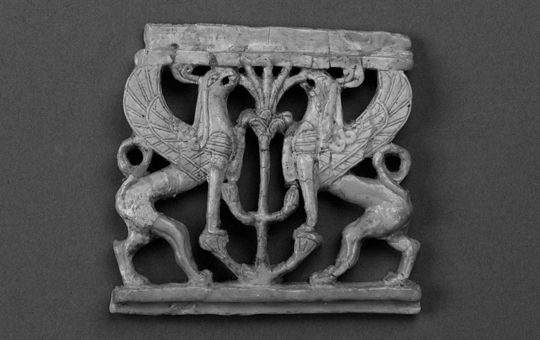
Vol. X / No. 3-4
By: Leon Legrain
Early Discoveries in Mesopotamia: The Babylonian Collections of the University Museum
A hundred years ago little was known concerning the ancient history of Assyria and Babylonia. Temples and palaces lay in […]
View Article
Vol. X / No. 3-4
By: Leon Legrain
Nippur: The Babylonian Collections of the University Museum
The interest of the American public in Oriental research is proved by the foundation of the American Oriental Society in […]
View Article
Vol. X / No. 3-4
By: Leon Legrain
Ur of the Chaldees: The Babylonian Collections of the University Museum
While the Nippur Expedition (1888-1900) was entirely supported by the Public-spirited Gentlemen of Philadelphia and the University of Pennsylvania, the […]
View Article
Vol. X / No. 3-4
By: Leon Legrain
al-‘Ubaid: The Babylonian Collections of the University Museum
Al-‘Ubaid has become a by-word of Mesopotamian archaeology. In the low mound four miles west of Ur was discovered an […]
View Article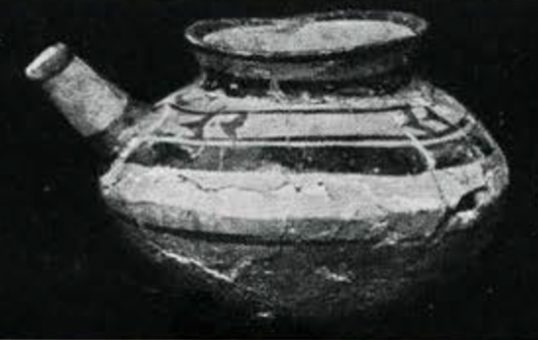
Vol. X / No. 3-4
By: Leon Legrain
The al-‘Ubaid Painted Pottery: The Babylonian Collections of the University Museum
Outside of the temple, the old al-‘Ubaid cemetery, the graves of which rest on virgin soil, carries us back centuries […]
View Article
Vol. X / No. 3-4
By: Leon Legrain
The Sumerians: The Babylonian Collections of the University Museum
The political independence of the Sumerians came to an end when Hammurabi united the north and the south, Akkad and […]
View Article
Vol. X / No. 3-4
By: Leon Legrain
The Uruk Period: The Babylonian Collections of the University Museum
Such is the picture of the first establishment of the Sumerians in southern Mesopotamia as revealed by the German excavations […]
View Article
Vol. X / No. 3-4
By: Leon Legrain
Tell ‘Uqair “Painted Temple”: The Babylonian Collections of the University Museum
A still more perfectly preserved example of an early Sumerian temple has been recently (1940) unearthed at Tell ‘Uqair, forty […]
View Article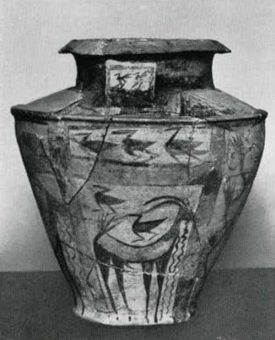
Vol. X / No. 3-4
By: Leon Legrain
The Jemdet-Nasr Period: The Babylonian Collections of the University Museum
The brilliant decoration of Tell ‘Uqair shows a taste for colours was not foreign to the Uruk period, even when […]
View Article
Vol. X / No. 3-4
By: Leon Legrain
Kish (Uhaimir): The Babylonian Collections of the University Museum
Kish, eight miles east of Babylon, is, according to the king’s lists compiled about 1800 B.C., the site of the […]
View Article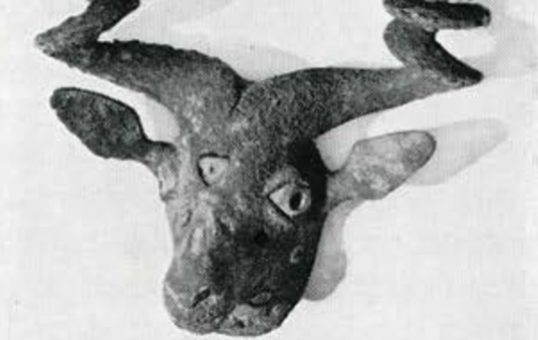
Vol. X / No. 3-4
By: Leon Legrain
Fâra: The Babylonian Collections of the University Museum
The hero of the Flood, Uta-napishtum, the Sumerian Noah, lived at Shuruppak (Fâra), a city on the old Euphrates, half […]
View Article
Vol. X / No. 3-4
By: Leon Legrain
Khafaje and Tell Asmar: The Babylonian Collections of the University Museum
East of Baghdad, across the Tigris, in the plains watered by the Diala, where the highways of Elam, Persia and […]
View Article
Vol. X / No. 3-4
By: Leon Legrain
Ashur and Mari: The Babylonian Collections of the University Museum
The influence of the Sumerian culture extended far outside southern Mesopotamia, as revealed by the excavations at Ashur, the first […]
View Article
Vol. X / No. 3-4
By: Leon Legrain
Elam. Isin-Larsa: The Babylonian Collections of the University Museum
Elam, across the Persian Gulf on the borderland of Persia, has always been in close relation with the Sumerian south. […]
View Article
Vol. X / No. 3-4
By: Leon Legrain
India and Egypt: The Babylonian Collections of the University Museum
Semitic supremacy over lower and upper Mesopotamia was thus achieved at the beginning of the second millennium by the kings […]
View Article
Vol. X / No. 3-4
By: Leon Legrain
Sargon of Agade: The Babylonian Collections of the University Museum
The excavations of the last twenty years have thus revealed the origin and progress of a Sumerian culture in southern […]
View Article
Vol. X / No. 3-4
By: Leon Legrain
Lagash (Tello): The Babylonian Collections of the University Museum
For over a century the Guti, hill-tribes of the eastern highland, dominated southern Mesopotamia after they had ruined the empire […]
View Article
Vol. X / No. 3-4
By: Leon Legrain
The Third Dynasty of Ur. The Stela of Ur – Nammu: The Babylonian Collections of the University Museum
The stela of Ur-Nammu, the largest sculptured slab recovered at Ur, is a monumental record of the building activities of […]
View Article
Vol. X / No. 3-4
By: Leon Legrain
The Isin-Larsa Dynasties: The Babylonian Collections of the University Museum
The cult of the moon-god survived the ruin of the city. After forty years the statue of Nannar was brought […]
View Article
Vol. X / No. 3-4
By: Leon Legrain
The First Dynasty of Babylon: The Babylonian Collections of the University Museum
In the second millennium B.C., the Semitic language became the current and official language of Babylonia and Assyria, while Sumerian […]
View Article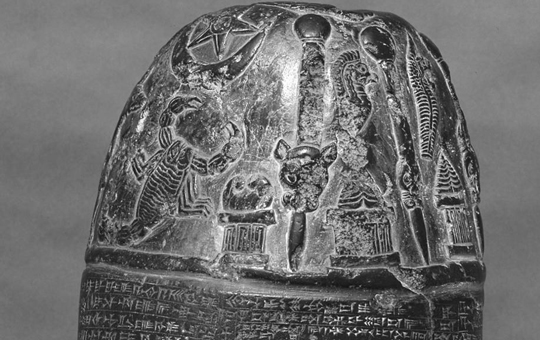
Vol. X / No. 3-4
By: Leon Legrain
The Cassite Dynasty: The Babylonian Collections of the University Museum
From the east and the west new people were soon to invade Mesopotamia. From the Taurus range the Hittites descended […]
View Article
Vol. X / No. 3-4
By: Leon Legrain
The Assyrian Period: The Babylonian Collections of the University Museum
The names of the kings of Assyria who reigned in the great city of Nineveh in the eighth and seventh […]
View Article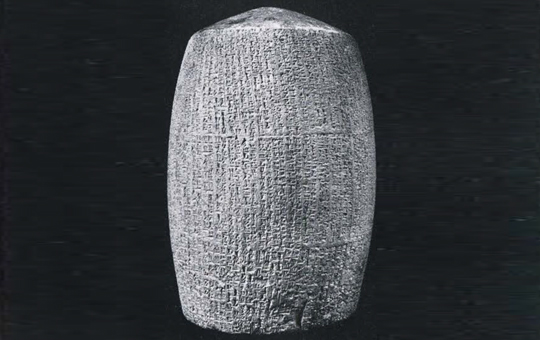
Vol. X / No. 3-4
By: Leon Legrain
The Neo-Babylonian Period: The Babylonian Collections of the University Museum
Foreign rule was deeply resented by the Babylonians. The fall of Nineveh which filled the Orient with stupor found them […]
View Article
Vol. X / No. 3-4
By: Leon Legrain
The Persian Period: The Babylonian Collections of the University Museum
The capture of Babylon by Cyrus in 539 B.C., almost a century after the ruin of Nineveh, sealed the destiny […]
View Article
Vol. X / No. 3-4
By: Leon Legrain
The Greek Period: The Babylonian Collections of the University Museum
In 331 B.C., Alexander, after the battle of Arbela, entered Babylon and added Persia to his previous conquest of Asia […]
View Article
Vol. X / No. 3-4
By: Leon Legrain
The Parthian Period: The Babylonian Collections of the University Museum
Large constructions of that period, like the fortress built on the top of the Ziggurat and a Parthian palace, called […]
View Article
Vol. X / No. 3-4
By: Leon Legrain
The Sassanians and the Arabs: The Babylonian Collections of the University Museum
In 226 A.D. another Persian dynasty, the Sassanian, succeeded the Parthian. Ctesiphon became the winter residence. From that epoch dates […]
View Article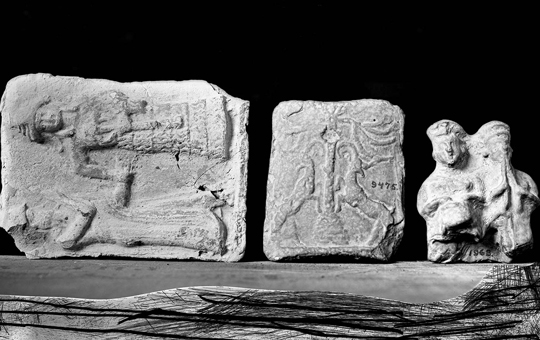
Vol. X / No. 3-4
By: Leon Legrain
The Nippur Seal and Terracotta Collections: The Babylonian Collections of the University Museum
Seals and terracottas are eminently characteristic of the Mesopotamian culture. They are found in all the levels and in all […]
View Article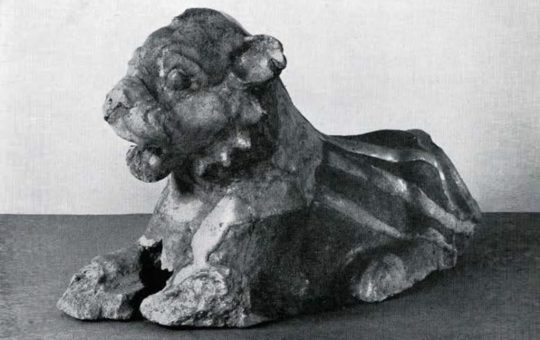
Vol. X / No. 3-4
By: Leon Legrain
Nuzi: The Babylonian Collections of the University Museum
In the last decades, excavations in northern Mesopotamia, in the plains east of the Tigris, which were to be the […]
View Article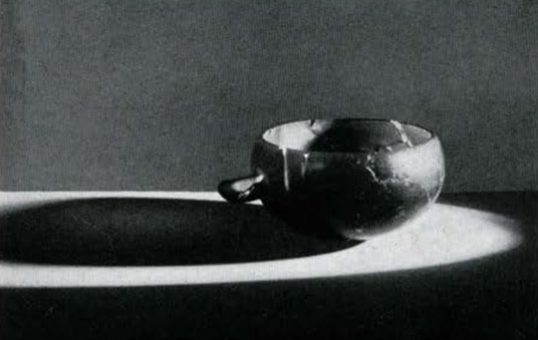
Vol. X / No. 3-4
By: Leon Legrain
Tepe Gawra and Tell Billa: The Babylonian Collections of the University Museum
The artificial mound of Tepe Gawra, fifteen miles east from Mosul, two miles from Khorsabad, covers a much older settlement. […]
View Article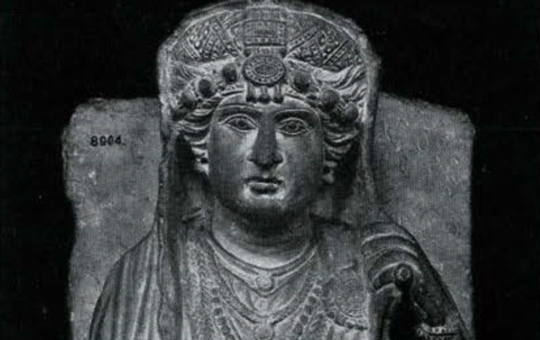
Vol. X / No. 3-4
By: Leon Legrain
Palmyra: The Babylonian Collections of the University Museum
Small collections of antiquities from countries bordering on Mesopotamia have been acquired by purchase by the University Museum and are […]
View Article
Vol. X / No. 3-4
By: Leon Legrain
The Luristan Bronzes: The Babylonian Collections of the University Museum
On the border of Mesopotamia, Luristan is the highland of Persia, between Hamadan and “Shushan the Palace,” on both banks […]
View Article
Vol. X / No. 3-4
By: Leon Legrain
The Sabaean Collection: The Babylonian Collections of the University Museum
The land of Saba forms the southwest corner of Arabia on the Red Sea. There reigned long before Muhammed and […]
View Article
Vol. XI / No. 1-2
By: H. A. Weischhoff
Preface: The African Collections of the University Museum
VISITORS to the galleries of a museum which, like the University Museum, exhibits the arts and crafts of non-European peoples, […]
View Article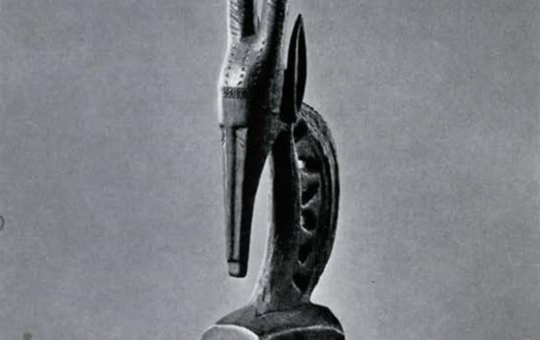
Vol. XI / No. 1-2
By: H. A. Weischhoff
Introduction: The African Collections of the University Museum
AFRICA was the last continent to be drawn into the orbit of European interest. Less than a hundred years ago […]
View Article
Vol. XI / No. 1-2
By: H. A. Weischhoff
I. Africa’s History: The African Collections of the University Museum
General Historians who are accustomed to reconstruct history from written documents or from tablets or papyri do not find a […]
View Article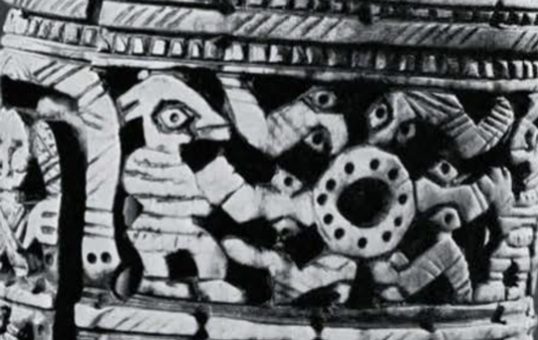
Vol. XI / No. 1-2
By: H. A. Weischhoff
II. The Cultures of Africa: The African Collections of the University Museum
Most of us have vague ideas about other peoples, and only rarely are we aware of the complexities underlying the […]
View Article
Vol. XI / No. 1-2
By: H. A. Weischhoff
Suggested Reading: The African Collections of the University Museum
Tribal Monographs Evans-Pritchard, E. E., Witchcraft, Oracles, and Magic among the Azande, London, 1937. Herskovits, M. J., Dahomey; an Ancient […]
View Article
Vol. XI / No. 3
By: Marian Angell Godfrey
Foreword: Primitive Money
THIS number of the Bulletin has been planned not only to accompany but also to outlast a special exhibition, The […]
View Article
Vol. XI / No. 3
By: H. A. Weischhoff
Introduction: Primitive Money
THIS bulletin proposes to deal with money and the various concepts regarding money insofar as they affect the so-called primitive […]
View Article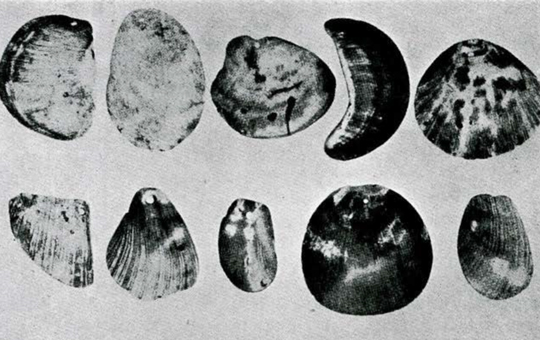
Vol. XI / No. 3
By: H. A. Weischhoff
I. What Is Money?: Primitive Money
In an age in which money has become the ultima ratio of human society and in which its function has […]
View Article
Vol. XI / No. 3
By: H. A. Weischhoff
II. Origin of Money: Primitive Money
The origin of money, like all problems of a similar nature, is a question which is invariably raised by scholars […]
View Article
Vol. XI / No. 3
By: H. A. Weischhoff
III. Types of Money: Primitive Money
In enumerating the most important types of money which have had validity among primitive peoples, the following arrangement has been […]
View Article
Vol. XI / No. 3
By: H. A. Weischhoff
Suggested Reading: Primitive Money
For those who should like to pursue this subject farther than this short bulletin allows, the following list of publications […]
View Article
Vol. XI / No. 4
By: J. A. N.
Houses and Homes
SOME one has said it takes a heap of living to make a home. This statement suggests that while a […]
View Article
Vol. XI / No. 4
By: L. S. Jr.
Incense Burning at Piedras Negras
WHY do institutions like our Museum dig out the dead bones of the past? Certainly a prime consideration is often […]
View Article
Vol. XI / No. 4
By: H. N. W.
Attu Treasure
FOR Attu, the international date-line deflects from its even curve, thus, in the sense of time, annexing to our hemisphere […]
View Article
Vol. XI / No. 4
By: L. L.
Horseback Riding in Mesopotamia in the Third Millennium B.C.
HORSEBACK riding in Southern Mesopotamia in the Third Millennium was not a sport for either gods, kings, or men, because […]
View Article
Vol. XII / No. 1-2
By: Marian Angell Godfrey
Foreword: The Educational Department
It is with great pride that we present this report of the Educational Department. For many years the Department has […]
View Article
Vol. XII / No. 1-2
By: Eleanor M. Moore
Introduction: The Educational Department
THE responsibilities of a museum are threefold: to safeguard for present and future generations the material evidence of man’s contributions […]
View Article
Vol. XII / No. 1-2
By: Eleanor M. Moore
Educational Services Within the Museum: The Educational Department
FROM THE CHILD in the first grade who is interested in “How the Indians Lived” to the occupational therapist or […]
View Article
Vol. XII / No. 1-2
By: Eleanor M. Moore
Educational Services Outside the Museum: The Educational Department
AN EXTENSION department was formed when the need arose for the lending of objects, as the number of Museum visits […]
View Article
Vol. XII / No. 3-4
By: D. Sutherland Davidson
Preface: The Oceanic Collections of the University Museum
ACKNOWLEDGMENTS Miss Jean Franckaen for the Cover Design of a Mortlock Island Mask, Micronesia. Mr. Reuben Goldberg for the Photographs. […]
View Article
Vol. XII / No. 3-4
By: D. Sutherland Davidson
The Pacific Area: The Oceanic Collections of the University Museum
THE Pacific Ocean, which extends nine thousand miles east and west at the equator and eight thousand miles north and […]
View Article
Vol. XII / No. 3-4
By: D. Sutherland Davidson
Prehistoric Types of Man: The Oceanic Collections of the University Museum
So little is known of the archaeology of the Pacific regions that it still is uncertain whether any of the […]
View Article
Vol. XII / No. 3-4
By: D. Sutherland Davidson
Prehistoric Ancestors of Modern Types of Man: The Oceanic Collections of the University Museum
SOMETIME toward the end of the Third Interglacial Period other types of man began to arrive in the East Indies. […]
View Article
Vol. XII / No. 3-4
By: D. Sutherland Davidson.
Living Types of Man in the Pacific Region: The Oceanic Collections of the University Museum
THE lack of archaeological data to show the sequence of physical types of man in the various Pacific areas from […]
View Article
Vol. XII / No. 3-4
By: D. Sutherland Davidson
Languages: The Oceanic Collections of the University Museum
THE languages spoken in the Pacific area in historic times are numerous and quite diverse in character. In some cases, […]
View Article
Vol. XII / No. 3-4
By: D. Sutherland Davidson
Archaeology: The Oceanic Collections of the University Museum
THE archaeology of the Pacific regions has received scant attention. Very little evidence is available in any of the major […]
View Article
Vol. XII / No. 3-4
By: D. Sutherland Davidson
Historic Cultures of the Pacific: The Oceanic Collections of the University Museum
WHEN the Europeans arrived in the Pacific in the sixteenth century they found representative cultures of the Palaeolithic, Neolithic, Bronze […]
View Article
Vol. XII / No. 3-4
By: D. Sutherland Davidson
The Future: The Oceanic Collections of the University Museum
THE future offers divergent paths to the native peoples of the Pacific and in neither case will the route they […]
View Article
Vol. XII / No. 3-4
By: D. Sutherland Davidson
Suggested Reading: The Oceanic Collections of the University Museum
BUCK, P. H. Vikings of the Sunrise, New York, 1938 COLE, F. C. The Peoples of Malaysia, New York, 1945 […]
View Article
Vol. XIII / No. 1
By: Froelich G. Rainey
Foreword
This issue of the Bulletin is an illustrated synopsis of the University Museum’s special Hallowe’en exhibit, Mask Parade-a bizarre collection […]
View Article
Vol. XIII / No. 2
By: Samuel Noah Kramer
Iraqi Excavations During the War Years
THE land now known as Iraq corresponds to much of the territory more commonly known as Mesopotamia, “the land amid […]
View Article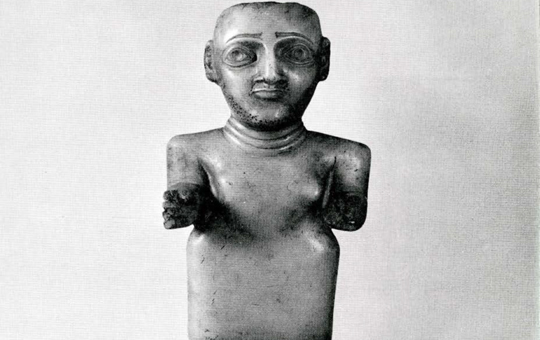
Vol. XIII / No. 3
By: F. G. R.
From the Director
Recent appointments to the University Museum staff, I believe, reflect a policy of calculated optimism. Most of the new men […]
View Article
Vol. XIII / No. 3
By: J. F. D.
Kourion: Past Achievements and Future Plans
Now that we are perfecting plans for a number of new excavations, it may be well to look back on […]
View Article
Vol. XIII / No. 3
By: P. Dikaios
Trial Excavations at Sotira: Site Teppés On Behalf of the University Museum Cyprus Expedition
The scope of the excavations at Kourion has been broadened to include the investigation of a Neolithic site near Sotira, […]
View Article
Vol. XIII / No. 3
By: H. Ranke
An Egyptian Tombstone From a Period of Transition
The limestone slab1 published here for the first time2 is a characteristic and unusually well-preserved document of the latter part3 […]
View Article
Vol. XIII / No. 4
By: L. Legrain
Nippur Fifty Years Ago
The seventh of October this year a joint expedition of the University Museum of the University of Pennsylvania and the […]
View Article
Vol. XIV / No. 1
By: Francis R. Steele
Nippur Today
Plans Laid Forty-nine years ago this May, John Henry Haynes closed the fourth season of work at Nippur, packed his […]
View Article
Vol. XIV / No. 2
By: Schuyler Cammann
Acquiring Merit in Lama Lands: Glimpses of the Lama Religion in Tibet and Mongolia
On a series of trips through the Tibetan borderlands of West China and Northern India, some years ago, and in […]
View Article
Vol. XIV / No. 2
By: Schuyler Cammann
A Prince of the Lama Church: Glimpses of the Lama Religion in Tibet and Mongolia
Our brief glimpse at the more popular aspects of Tibetan Buddhism may have made it seem a very simple faith. […]
View Article
Vol. XIV / No. 3
By: C.-J. H.
Warp and Woof
WARP AND WOOF, the University Museum’s current exhibit of historic and contemporary textiles, has a double aim: to spread before […]
View Article
Vol. XIV / No. 4
By: J. L. G.
Traces of Early Man on the North Bering Sea Coast
(Mr. Giddings, who is associated with the University Museum during his year’s leave of absence from the University of Alaska […]
View Article
Vol. XIV / No. 4
By: G. H. McF.
Kourion: The Apollo Baths
Excavations were resumed on the site of the Sanctuary of Apollo during the first week of April of 1949. The […]
View Article
Vol. XIV / No. 4
By: De Coursey Fales, Jr.
Kourion: The Amusement Area
Man has always required entertainment and recreation. As today a man goes to a baseball park or movie-house, so in […]
View Article
Vol. XV / No. 1
By: J.A.M.
Frank Gouldsmith Speck: 1881-1950
On February 6, 1950, Dr. Frank G. Speck passed away at the University Hospital. He had been in failing health […]
View Article
Vol. XV / No. 1
By: Frank Gouldsmith Speck
Introduction
The use of the mask in various forms of symbolic activity, religious or dramatic, is found in many parts of […]
View Article
Vol. XV / No. 1
By: Frank Gouldsmith Speck
Concerning Iconology and the Masking Complex in Eastern North America
IROQUOIAN LINGUISTIC STOCK NORTHERN DIVISION Iroquois Cayuga, Onondaga, Seneca (Ontario and New York State) An outstanding feature in the religious […]
View Article
Vol. XV / No. 1
By: Frank Gouldsmith Speck
Summary and Conclusions
The masking complex of the East, taken as a cultural phenomenon ranging from the Labrador area to Florida, fails to […]
View Article
Vol. XV / No. 2-3
By: Hermann Ranke
A Sketch of Egyptian Chronology: The Egyptian Collections of the University Museum
Prehistoric Period Before 3200 B.C. The Old Kingdom ca. 3200-2280 Archaic period (dynasties 1-3): ca. 3200-2680 Pyramid period (dynasties 4-6): […]
View Article
Vol. XV / No. 2-3
By: Hermann Ranke
A Sketch of the Geography and History of Egypt: The Egyptian Collections of the University Museum
EGYPT, situated in the northeastern corner of Africa, is a small country, if compared with the huge continent of which […]
View Article
Vol. XV / No. 2-3
By: Hermann Ranke
Egyptian Deities and Their Sacred Animals: The Egyptian Collections of the University Museum
The Egyptians, throughout their history, have been most god-fearing people. But they did not believe in only one god as […]
View Article
Vol. XV / No. 2-3
By: Hermann Ranke
A Guide to the Egyptian Collections: The Egyptian Collections of the University Museum
The objects forming the present collections of the University Museum were acquired in various ways. In the early days-the Museum […]
View Article
Vol. XV / No. 4
By: F. G. R.
The Museum Takes Inventory*
Title Footnote In the Museum Bulletin for June 1948 I reported the decision of the Board of Managers and the […]
View Article
Vol. XV / No. 4
By: S. V. R. C.
The Story of Hornbill Ivory
The strange substance called “hornbill ivory” was formerly an important commodity in Asiatic trade, and it was extensively carved, especially […]
View Article
Vol. XVI / No. 1
By: R. S. Y
Gordion: 1950
Seventy miles to the southwest of Ankara a long low mound-its Turkish name, Yassihuyuk, means just that-rises beside the Sangarios […]
View Article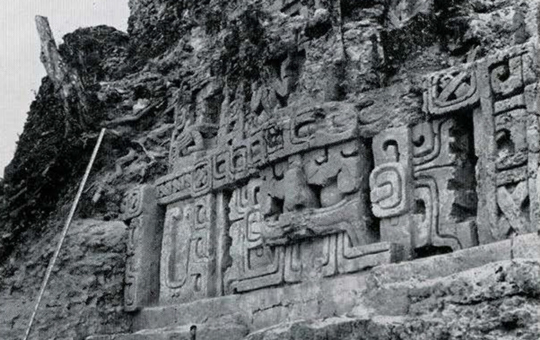
Vol. XVI / No. 1
By: L. S., Jr.
Reconnaissance in British Honduras
The eastern margin of the Classical “Old Empire” Maya area runs through the Crown Colony of British Honduras, between the […]
View Article
Vol. XVI / No. 2
By: D. McC.
Nippur: The Holy City
When I first saw Nippur on a bright fall day in overwhelmed by its size, the dunes of sand covering […]
View Article
Vol. XVI / No. 2
By: F. R. S.
Writing and History: The New Tablets From Nippur
All objects recovered by the archaeologist make a twofold contribution to the general information about the site under excavation. On […]
View Article
Vol. XVI / No. 2
By: S. N. K.
Mercy, Wisdom, and Justice: Some New Documents From Nippur
One of the major goals of the new Joint Expedition to Nippur was to recover as many as possible of […]
View Article
Vol. XVI / No. 3
By: A. K., II
Foreword: 14 Eyes in a Museum Storeroom
Every large museum, and most smaller ones, have far more specimens than can possibly be exhibited at the same time. […]
View Article
Vol. XVI / No. 3
By: Franklin C. Watkins
Franklin C. Watkins: Painter
Mr. Watkins liked this bamboo zither from Borneo and said: In the room where all the musical instruments are stored […]
View Article
Vol. XVI / No. 3
By: Jacques Lipchitz
Jacques Lipchitz: Sculptor
Mr. Lipchitz was asked why he had chosen this Mayan stone relief from Honduras, and he said: When you asked […]
View Article
Vol. XVI / No. 3
By: Norman Bel Geddes
Norman Bel Geddes: Designer
Of this sculptured Mayan death’s head from Guatemala, Mr. Bel Geddes said: This intrigues me. I don’t especially like it […]
View Article
Vol. XVI / No. 3
By: Charles Addams
Charles Addams: ...Of The New Yorker
Charles Addams chose this figure of a whale from a Tlingit helmet, Southeast Alaska, and remarked: These objects were selected […]
View Article
Vol. XVI / No. 3
By: Louis E. Stern
Louis E. Stern: Collector
Pottery of the 15th century A.D. from Lago de Ajudante, Brazil, interested Mr. Stern. I was attracted by the grace […]
View Article
Vol. XVI / No. 3
By: Rene D'Harnoncourt
Rene D’Harnoncourt: Museum of Modern Art
Mr. d’Harnoncourt chose a Sepik River wood sculpture from New Guinea. That is a fine thing without any qualification. I […]
View Article
Vol. XVI / No. 3
By: Lincoln Kirstein
Lincoln Kirstein: Ballet
Mr. Kirstein was the only selector to choose a piece from the Museum’s large New Ireland collection. Of this dance […]
View Article
Vol. XVI / No. 4
By: Theodore A. Seder
Old World Overtones in the New World: Some Parallels With North American Indian Musical Instruments
*Title Reference For many generations the question of the origin of the American Indian has aroused great interest, and archaeological […]
View Article
Vol. XVII / No. 1
By: W. H. G.
Ethnological Reconnaissance in New Guinea
Some of the finest of the University Museum’s collections come from New Guinea and the adjacent islands. For some time, […]
View Article
Vol. XVII / No. 1
By: Keith Little
My Father, The Crocodile: A Papuan Legend
During my recent visit to Papua and New Guinea, I had occasion to spend a weekend at the Sogeri Education […]
View Article
Vol. XVII / No. 1
By: P. Dikaios
Excavations at Sotira: 1951*
Subtitle Reference In the summer of 1951 Mr. P. Dikaios, Curator of the Cyprus Museum, excavated at Sotira, the settlement […]
View Article
Vol. XVII / No. 2
By: Samuel Noah Kramer
Background and Purpose: A "Fulbright" in Turkey
Early in September 1951 I came to Istanbul as the first Fulbright Research Scholar appointed by the United States Educational […]
View Article
Vol. XVII / No. 2
By: Samuel Noah Kramer
Work Done: A "Fulbright" in Turkey
Upon arrival in Istanbul, I called immediately upon Mr. Aziz Ogan, the Director of the Archaeological museums of that city, […]
View Article
Vol. XVII / No. 2
By: Samuel Noah Kramer
Law and Love, A Hymn, A Prayer, and a Word to the Wise: A "Fulbright" in Turkey
In order to illustrate concretely the character of the contents of some of the material copied during the Fulbright year […]
View Article
Vol. XVII / No. 2
By: Samuel Noah Kramer
Anatolian Archaeology: Two Outstanding Turkish Excavations
A "Fulbright" in Turkey
October 29th of next year will mark the thirtieth anniversary of the birth of the Turkish Republic. On that day, […]
View Article
Vol. XVII / No. 3
By: Schuyler Cammann
I. Chinese Mandarin Squares
INTRODUCTION The Chinese were the first people in the world to use silk, and the finest products of Chinese weaving […]
View Article
Vol. XVII / No. 3
By: Schuyler Cammann
II. Brief Catalogue of the Letcher Collection
A. MING BADGES Circular medallion from the robe of a Ming Emperor, showing a powerful winged dragon (ying) pursuing its […]
View Article
Vol. XVII / No. 4
By: Rodney S. Young
Progress at Gordion: 1951-1952
A comparison of the plan of the city mound at Gordian as it was left at the end of the […]
View Article
Vol. XVII / No. 4
By: Froelich Rainey
Afghanistan
The reconnaissance described here has been followed in the summer of 1953 by the University Museum Expedition to Afghanistan under […]
View Article
Vol. XVII / No. 4
By: Rudolf Anthes
Hermann Ranke: 1878-1953
Hermann Ranke, former Curator of the Egyptian Section, died April 22nd, 1953, at Freiburg, Germany, in his 75th year. At […]
View Article
Vol. XVIII / No. 1-2
By: Linton Satterthwaite Jr.
Sculptured Monuments From Caracol, British Honduras*
Title Reference* In the BULLETIN of May, 1951 (Vol. 16, No. 1) we gave some account of explorations at a […]
View Article
Vol. XVIII / No. 1-2
By: Horace Willcox
Removal and Restoration of the Monuments of Caracol
The 1951 expedition of the University Museum to British Honduras brought out a substantial tonnage of Maya stelae and altars. […]
View Article
Vol. XVIII / No. 3
By: Schuyler Cammann
Carvings in Walrus Ivory
When anyone mentions walrus ivory, we immediately think of small Eskimo carvings from the northernmost parts of the world. The […]
View Article
Vol. XVIII / No. 3
By: Richard Emerick
The Havasupais: People of Cataract Canyon1
The American Southwest is known the world over for its unique, colorful, almost frightening beauty and there is no more […]
View Article
Vol. XVIII / No. 4
By: Froelich Rainey
Tradition and Change
The excitement of discovery was the compelling force responsible for the founding of the University Museum in the last century. […]
View Article
Vol. XIX / No. 1
By: Brandon Barringer
On the Track of the Black Pig
“Cian mic Cainte was a wicked Druid who kept an academy near Drogheda, and was wont to change his pupils […]
View Article
Vol. XIX / No. 1
By: Ward Goodenough
The Pageant of Death in Nakanai: A Report of the 1954 Expedition to New Britain
Romantic tradition in the western world pictures primitive communities as exciting combinations of colorful dress, bizarre customs, and sinister rites. […]
View Article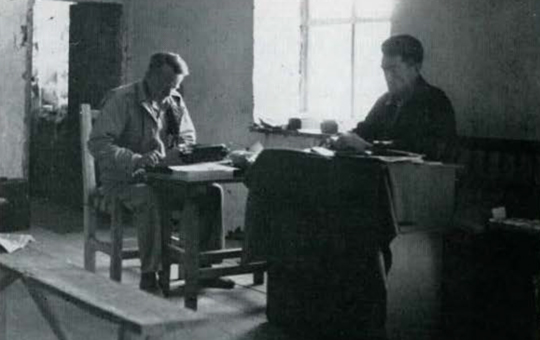
Vol. XIX / No. 2
By: J. Alden Mason
Linguistic Research in the University Museum
It is generally taken for granted that Museum expeditions, archaeological or ethnological, will be productive of tangible results, of objects […]
View Article
Vol. XIX / No. 2
By: William R. Coe
Excavations in El Salvador
One facet of the Museum’s long-standing interest in Mesoamerica is its present concern with the prehistory of El Salvador. Interest […]
View Article
Vol. XIX / No. 2
By: Cynthia Griffin
The Museum Library
When the Museum building was erected the library was established and named the Elkins Library (1898). Some ask “Does anybody […]
View Article
Vol. XIX / No. 3
By: Froelich Rainey
The New Museum
This study of the contemporary museum in the western nations was begun for very practical reasons. In 1953, the University […]
View Article
Vol. XIX / No. 4
By: Samuel Noah Kramer
Tales of Sumer: Man's Oldest Myths
INTRODUCTION The summer of 1955 saw one of the most unusual exhibits in museum history on exhibit in Philadelphia’s University […]
View Article
Vol. XX / No. 1
By: Rudolf Anthes
A First Season of Excavating in Memphis
Excavating in Egypt means, in most cases, digging in the desert which adjoins the cultivated area of the valley of […]
View Article
Vol. XX / No. 1
By: H. G. Fischer
Prostrate Figures of Egyptian Kings
Those who visit the Egyptian galleries and see about them the imposing representations of the pharaohs which are displayed there-the […]
View Article
Vol. XX / No. 2
By: J. L. Giddings, Jr.
Forest Eskimos: An Ethnographic Sketch of Kobuk River People in the 1880's*
FOREWORD Three men and a woman were the chief narrators from whose accounts the following sketch is compounded. They were […]
View Article
Vol. XX / No. 3
By: Dudley T. Easby, Jr.
Sahagún Reviviscit: In the Gold Collection of the University Museum*
Aboriginal Quimbaya goldsmiths in the Cauca Valley of Colombia were turning out remarkable hollow gold castings long before the birth […]
View Article
Vol. XX / No. 3
By: Alfred Kidder, II
Digging in the Titicaca Basin
The University Museum undertook its first project in American archaeology in mid-1895 when Max Uhle was engaged by mail to […]
View Article
Vol. XX / No. 3
By: William R. Coe
A Thin Stone Head From Middle America
Justifiably famed in the field of Precolumbian Mexican art are various types of related sculpture whose origin appears to have […]
View Article
Vol. XX / No. 4
By: Froelich Rainey
The Tikal Project
When I came to the University Museum in 1947, Percy Madeira spoke to me of his hope that some day […]
View Article
Vol. XX / No. 4
By: Linton Satterthwaite, Jr.
Maya Dates on Stelae in Tikal “Enclosures”
In the leading article in this issue of the Bulletin Dr. Rainey gives an account of the Museum’s new project […]
View Article
Vol. XXI / No. 1
By: James B. Pritchard
Discovery of the Biblical Gibeon
Ancient Palestine, a small area equivalent to that of Sicily or Vermont, has had in the course of sixty-seven years […]
View Article
Vol. XXI / No. 1
By: Robert H. Dyson, Jr.
Iran: 19561
April is the Persian month. The plane wings over the high mountains ringing the plateau and finds them mostly free […]
View Article
Vol. XXI / No. 2
By: Rudolf Anthes
Memphis (Mit Rahineh) in 1956
Two main goals lay before me when I left for Mit Rahineh in January, 1956. First, to finish the 1955 […]
View Article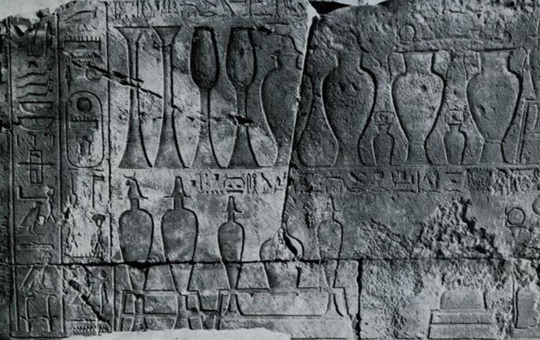
Vol. XXI / No. 2
By: H. G. Fischer
Further Remarks on the Prostrate Kings
It not infrequently happens that a dossier on some class of ancient objects is no sooner closed and the result […]
View Article
Vol. XXI / No. 3
By: Jane Goodale
“Alonga Bush”: A Tiwi Hunt
It was April when I arrived on Melville Island, in the company of a small group of men, with the […]
View Article
Vol. XXI / No. 3
By: Edwin M. Shook
The Tikal Project
Since John L. Stephen’s remarkable and justly famous account of his diplomatic journey (1839-1842) and archaeological discoveries in Central America […]
View Article
Vol. XXI / No. 4
By: Carleton S. Coon
Introduction: African Negro Sculpture
As you will shortly see-or have just seen-like other racial and ethnic areas, Negro Africa has its own special kind […]
View Article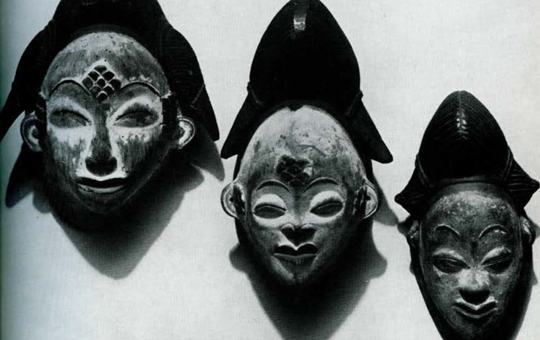
Vol. XXI / No. 4
By: Margaret Plass
A Walk Through the Gallery: African Negro Sculpture
The new African Gallery has been designed to exhibit, simply and honestly, a selection of sculptures from our permanent collections. […]
View Article
Vol. XXII / No. 1
By: Carleton S. Coon
Faces of Asia
This communication is one result of a trip around the world taken by Mrs. Coon and myself in the fall, […]
View Article
Vol. XXII / No. 2
By: G. Roger Edwards
Italy and Rome
The most recent in a long series of remodelled galleries of the Museum were completed in April of this year. […]
View Article
Vol. XXII / No. 2
By: James B. Pritchard
A Second Excavation at Gibeon
At the beginning of the 1957 season at el-Jib, the site of the biblical Gibeon, we had a modest and […]
View Article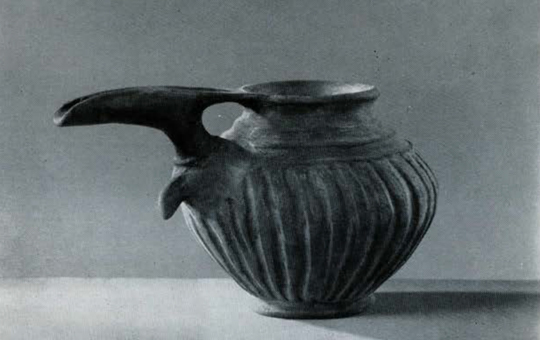
Vol. XXII / No. 2
By: Robert H. Dyson, Jr.
Iran 1957: Iron Age Hasanlu
During the summer of 1957, excavations at Hasanlu, near the south shore of Lake Urmia, were carried out as part […]
View Article
